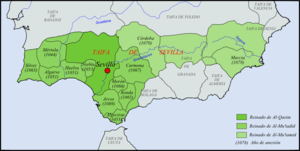Taifa of Seville
| Taifa Kingdom of Seville طائفة إشبيليّة Reino Taifa de Sevilla | |||||||||
|---|---|---|---|---|---|---|---|---|---|
| 1023–1091 | |||||||||
 The Kingdom of Seville at its greatest extent in green, c. 1080. (1078) year of annexation. | |||||||||
| Capital | Seville | ||||||||
| Common languages | Arabic, Berber, Mozarabic , Hebrew | ||||||||
| Religion | Islam, Roman Catholicism, Judaism | ||||||||
| Government | Monarchy | ||||||||
| Historical era | Middle Ages | ||||||||
• Downfall of Caliphate of Córdoba | 1023 | ||||||||
• Death of last king Al-Mu'tamid and defeat after Almoravid troops | 1091 | ||||||||
| Currency | Dirham and Dinar | ||||||||
| |||||||||
| Today part of |
| ||||||||
| Historical Arab states and dynasties | ||||||||||||||||||||||||||||||||||||||||||||||||||||||||||||
|---|---|---|---|---|---|---|---|---|---|---|---|---|---|---|---|---|---|---|---|---|---|---|---|---|---|---|---|---|---|---|---|---|---|---|---|---|---|---|---|---|---|---|---|---|---|---|---|---|---|---|---|---|---|---|---|---|---|---|---|---|
 | ||||||||||||||||||||||||||||||||||||||||||||||||||||||||||||
|
Ancient Arab States
|
||||||||||||||||||||||||||||||||||||||||||||||||||||||||||||
|
Eastern Dynasties
|
||||||||||||||||||||||||||||||||||||||||||||||||||||||||||||
|
Western Dynasties
|
||||||||||||||||||||||||||||||||||||||||||||||||||||||||||||
|
Arabian Peninsula
|
||||||||||||||||||||||||||||||||||||||||||||||||||||||||||||
|
Current monarchies
|
||||||||||||||||||||||||||||||||||||||||||||||||||||||||||||
The Taifa of Seville (Arabic: طائفة إشبيليّة, Ta'ifat-u Ishbiliyyah) was an Arab[1][2][3] kingdom which belonged to the Abbadid family. It originated in 1023 and lasted until 1091, in what is today southern Spain and Portugal.
History
The first king of Seville was Abu al-Qasim (1023–1042). He was qadi of Seville and declared independence of the province of Seville from Caliphate of Córdoba after its downfall in 1031, becoming king of Seville as Abbad I. The second king was his son Abbad II al-Mu'tadid (1042–1069), the last ruler being Muhammad al-Mu'tamid (1069–1091).
The kingdom started as a small, weakly defended territory comprising parts of current Spanish provinces of Seville, Huelva and Cadiz, but quickly emerged as the most powerful taifa kingdom of the time, after its rulers began pursuing a policy of expansion. After several military campaigns, the kingdom achieved dominance over all of Western Andalusia and Murcia, gradually absorbing the taifas of Badajoz, Algeciras, Granada and Málaga, Mértola (1044), Huelva (1051), Algarve (1051), Niebla (1053) Algeciras (1055), Silves (1063), Ronda (1065), Morón (1066), Carmona (1067), Arcos (1069) and even Córdoba itself (1070, lost in 1075 to Toledo but regained in 1077). The kingdom reached its largest territorial extent in 1078 with the capture of Murcia in 1078 by poet Abu Bakr ibn Ammar.
Nevertheless, the Abbad family was still subject to taxation by the King of Castile, to whom they were vassals. The drain of these taxes weakened the kingdom's power: al-Mu'tamid's decision to stop paying these taxes caused King Alfonso VI (who had already conquered Toledo in 1085) to besiege Seville. Al-Mu'tamid asked help from the Almoravids of Morocco against the Castilian king. The Moroccans established themselves at Algeciras, and after defeating the Christians occupied all the Islamic taifas, included, in 1091, Seville itself. After they ravaged the city, al-Mu'tamid ordered his sons to give up the royal fortress (early Alcazar of Seville) in order to save their lives. He was taken prisoner to Aghmat, Morocco, where he was assassinated in 1095.
Besides the intrigues and the eagerness for conquests of the kings, many artists of the time moved to the court of Seville, as the Almeria poet Ibn al-Abbâr, author of letters, and the poet Abû 'Âmir ibn Maslama and Abû'l-Walîd al-Himyarî, that made a compilation of the literary works of both ones.
Al-Mu'tadid also was a remarkable poet, having been taught by Ibn Ammar. On the other hand, he had a very cruel personality. His son al-Mu'tamid was even more dedicated to poetry than his father. He was friend of the poet Abu Bakr Muhammad Ibn al-`Ammâr, who was famous at that time after defeating the Castilian king Alfonso VI in a chess contest.
Al-Mu'tamid's sons, al-Rashid and al-Radi, were also very interested on arts, but had any interests on politics, and after the death of the king al-Mu'tamid, the Taifa of Seville was ruled by the Almoravids.
Al-Mu'tamid was lover of the future queen Itimad (Rumayqiyya). A brief tale on the queen Rumayqiyya appears on the book Libro de los ejemplos del Conde Lucanor y de Patronio (Book of the examples of Count Lucanor and Patronio), as the tale XXX, De lo que aconteció al rey Abenabed de Sevilla con su mujer, Ramaiquía (Tell of the story who happened to the king Abenabed of Seville with her wife, Ramaiquía).
Symbols
There are chronicles of that time that tells Almoravids fought under a white flag, while Andalusian soldiers as those of Sultan Al-Mu'tamid fought under different green flags with Islamic texts written on them. This is supposedly the origin of the current Andalusian flag, currently used as the autonomous region flag, called Arbonaida or Arbondaira.
See also
References
External links
| Wikimedia Commons has media related to Taifa of Seville. |